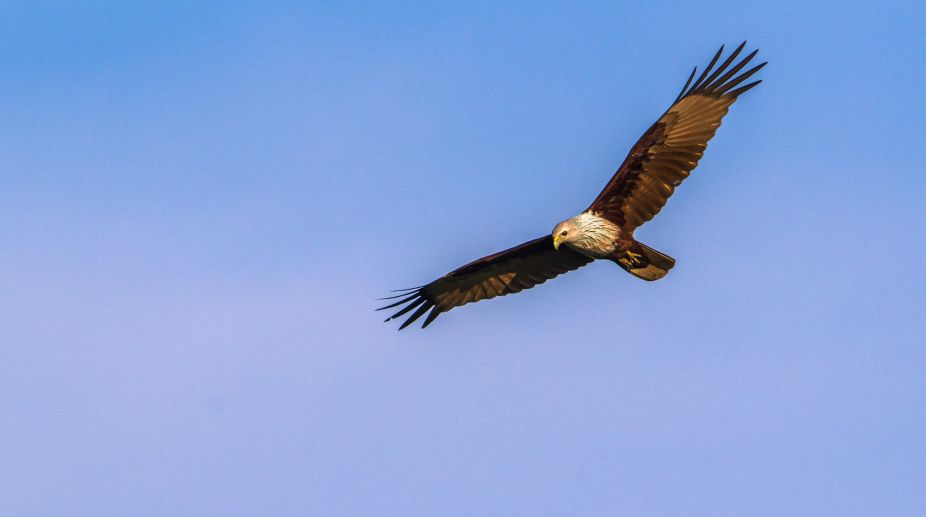Four arrested for kite flying
With four more arrests the total number of persons booked for flying kites with threads made of glass shards stood at 16.

(Photo: Getty Images)
The largest meat stall in Bangalore is at Russel Market, a spacious, roofed hall with many entrances, and a number of stone-topped cement tables in the open square behind, on which the carcasses are chopped up.
Hundreds of kites frequent the place, perched on the stall’s roof or on the parapets of a nearby mosque, expectant and alert, ready to dive down and retrieve any bit of cartilage or skin or even chopped bone thrown out as refuse.
Advertisement
Nowhere have I seen so many kites assembled though kites are common near all slaughterhouses and meatmarkets. I spent two mornings at Russel Market observing its kites.
Advertisement
Every now and again, bits of waste meat would be chucked out of the stall into the open square and at once the waiting kites would converge on the titbits, swift, even violent in their competitive raiding but uncannily silent.
In fact if I closed my eyes or turned my face away from the square I could not tell by ear alone when the kites swooped down on the refuse — there were a few optimist crows hanging around and I could hear their wings in fight as they tried to dart in and grab what they could, but never the much larger and heavier kites.
That struck me as something remarkable. Most birds of prey swooping down on their quarry cannot help the hiss of the air rushing past their stiff, half closed pinions — the sound of a peregrine’s stoop, even before the sickening thud of the impact of its hind claw with the prey is audible from quite some distance as I, who have lost many pigeons to the falcon, can tell.
Even the precipitate descent of eagles and vultures is marked by a loud swish and the spurt of a shikra chasing its victim through the air is audible.
Owls of course are utterly silent in fight, having a supersoft yielding webbing to their pinions and I cannot remember ever having heard a harrier’s wings but then I have never been really close to a fastflying harrier.
The sound of the primaries in fight depends upon their hardness and tightness of web and also partly on the slots between their tips.
Birds are often audible in flight — everyone must have heard the whinnying laughter of the wings of pigeons taking off. I collected a few fight-feathers of kites and studied them and they did seem soft in their webbing.
And I noticed that both when swooping down with closed wings (when, naturally, the pinions overlap) and when sailing up from the swoop with spread wings and the slots wide between the fights, kites are silent on the wing.
Some of the kites were very dark all over, almost a blackish Vandyke brown, and some quite light, a raw umber fading to a dull gold on the head — I thought the lighter bird were the older.
At such close quarters the comparative weakness of the beak and the small feet and claws, so unlike the powerful, great-taloned feet of many birds of prey, were very evident.
However, in flight the kites were as quick, sure and effortless as any eagle — for sheer dexterity of wing they are probably peerless.
I took many photographs to show how the yielding primaries of the kite give ripplingly to the force of the air’s resistance in a dive or upward sweep but owing to the groundglass of my reflex camera having been accidentally shifted out of alignment, got no pictures that did not show the birds flying right out of the frame — in fact the picture reproduced here was the only one in which the subject had not been decapitated! Such things happen in photography.
Show me the professional or advanced amateur who has never taken a picture with the lens-cap on, or without noticing that his viewfinder was out — and I will show you a liar!
This extraordinary silence of the raiding kite is something that many must have noticed, though perhaps not consciously.
If you have ever had some titbit snatched out of your hand by a thieving kite, you will remember that you saw or felt the bird before you were aware of it and that your ear never warned you.
There is a an open-air café in a city that I used to frequent years ago and here the opportunist kites were always on the lookout for the unwary and preoccupied.
I remember one evening when I was at this café with a man who argued that on a 35 mm camera, a telephoto lens produced a larger image than a lens of identical focal length on a camera of larger format.
At first I was very understanding; even kind to him, but as he stuck big-headedly and volubly to his view, my patience began to run out.
And just as this man was stubbornly saying the same thing for the twentieth time, gesticulating violently to emphasise his point, a kite swooped down and expertly snatched the vadai he had in his eloquent hand, putting an end to all argument.
I have liked kites ever since.
This was published on 2 may 1965 in The Sunday Statesman
Advertisement
With four more arrests the total number of persons booked for flying kites with threads made of glass shards stood at 16.
Leave gadgets and all worries to have a fun-filled 15th August dotting the sky with colourful kites.
Nature lovers in Siliguri have voiced concern after several black kites started falling ill in Siliguri since last night. While…
Advertisement
